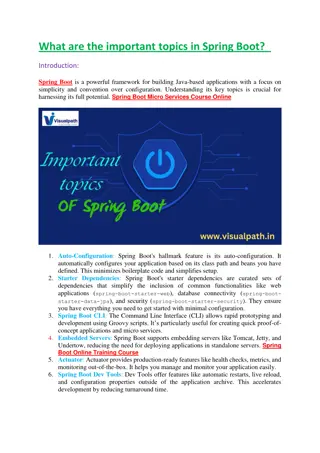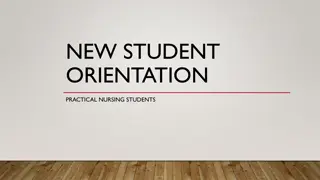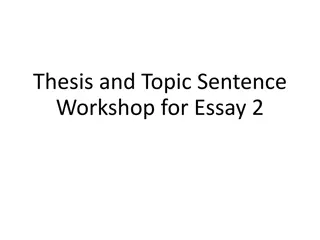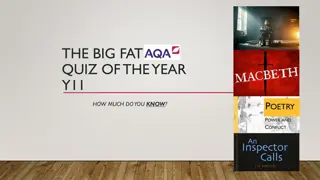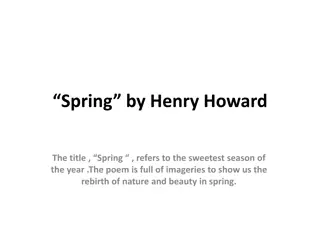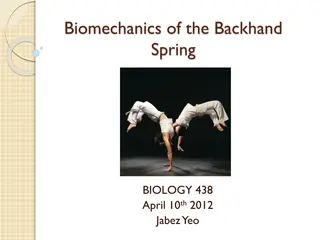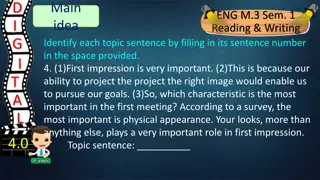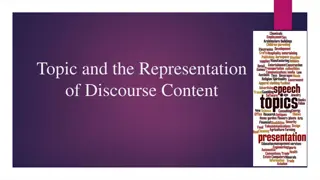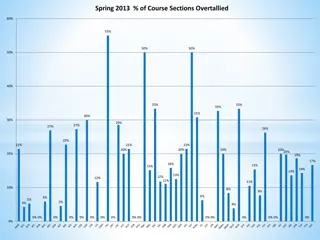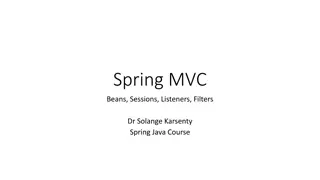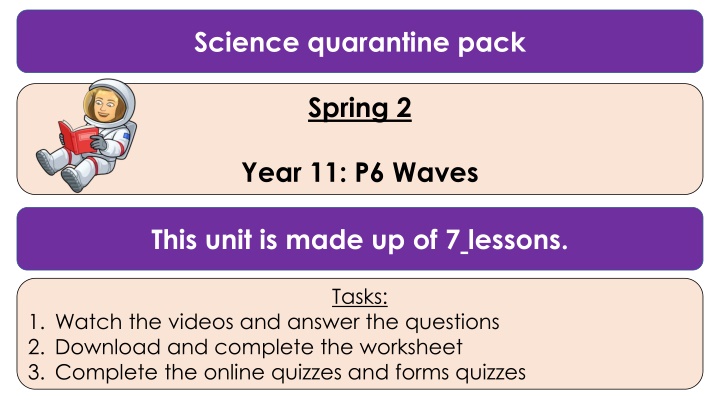
Waves: Longitudinal and Transverse Properties Explained
Explore the fundamental concepts of longitudinal and transverse waves through engaging videos, questions, worksheets, and quizzes. Learn about wave properties, measurements, and applications in this comprehensive study unit for Year 11 students.
Download Presentation

Please find below an Image/Link to download the presentation.
The content on the website is provided AS IS for your information and personal use only. It may not be sold, licensed, or shared on other websites without obtaining consent from the author. If you encounter any issues during the download, it is possible that the publisher has removed the file from their server.
You are allowed to download the files provided on this website for personal or commercial use, subject to the condition that they are used lawfully. All files are the property of their respective owners.
The content on the website is provided AS IS for your information and personal use only. It may not be sold, licensed, or shared on other websites without obtaining consent from the author.
E N D
Presentation Transcript
Science quarantine pack Spring 2 Year 11: P6 Waves This unit is made up of 7 lessons. Tasks: 1. Watch the videos and answer the questions 2. Download and complete the worksheet 3. Complete the online quizzes and forms quizzes
Title: Transverse and longitudinal waves Watch the following videos and read BBC Bitesize notes : https://www.youtube.com/watch?v=0f5iYCNCnow https://www.bbc.co.uk/bitesize/guides/z3yq4qt/revision/1 Answer the following questions: 1. What is a longitudinal wave? Give two examples 2. What is a transverse wave? Give two examples 3. What do all waves transfer? 4. What do ripples transfer? 5. What is an oscillation? 6. In which direction is energy transferred by transverse waves? 7. In which direction is energy transferred by transverse waves? 8. What are compressions and rarefactions 9. What are the differences between longitudinal and transverse waves. Complete the BBC test: https://www.bbc.co.uk/bitesize/guides/z3yq4qt/test
Check your learning, if you have any red or amber topics watch the videos and read through the BBC Bitesize notes again.
Title: Properties of waves Watch the video and read the BBC Bitesize notes: https://www.youtube.com/watch?v=ITe6snlZBp8 https://www.youtube.com/watch?v=Aucu7YshyQ0 https://www.bbc.co.uk/bitesize/guides/zwkn2nb/revision/1 https://classroom.thenational.academy/lessons/wave-properties-60vk0d?step=1&activity=video https://classroom.thenational.academy/lessons/measuring-the-speed-of-waves-in-solids-c9gk6t?step=1&activity=video Answer the following questions: 1. What do waves do? 2. Draw a labelled diagram to show a waves: wavelength, amplitude, wave peak and wave trough. 3. Give the equation to calculate the time of a wave 4. Give the equation to calculate wave speed. 5. How could you calculate the speed of sound in air? 6. What do the particles in a wave do? 7. What is an oscillation? 8. Define a longitudinal wave 9. Define a transverse wave 10.What is a mechanical wave? 11.Give two examples of longitudinal waves 12.Give two examples of transverse waves 13.What is the difference between a peak and amplitude? 14.What are the units of wavelength?
Title: Properties of waves Watch the video and read the BBC Bitesize notes: https://www.youtube.com/watch?v=OY0lXHPo_nM https://www.youtube.com/watch?v=UNmv6H-f180 https://www.youtube.com/watch?v=ZXAmiRC0GBo https://www.bbc.co.uk/bitesize/guides/zwkn2nb/revision/4 https://www.bbc.co.uk/bitesize/guides/zwkn2nb/revision/5 Answer the following questions: 1. Describe a method to Measure the frequency, wavelength and speed of waves in a ripple Tank. 2. Describe a method to Measure the frequency, wavelength and speed of waves in a solid. Download and complete the following worksheets: https://classroom.thenational.academy/lessons/wave-properties-60vk0d?step=2&activity=worksheet https://classroom.thenational.academy/lessons/measuring-the-speed-of-waves-in-solids- c9gk6t?step=2&activity=worksheet Complete the quizzes https://classroom.thenational.academy/lessons/wave-properties- 60vk0d?step=3&activity=exit_quiz Complete the following test: https://www.bbc.co.uk/bitesize/guides/zwkn2nb/test
Check your learning, if you have any red or amber topics watch the videos and read through the BBC Bitesize notes again.
Title: Types of electromagnetic waves Watch the following video and read the BBC Bitesize notes: https://classroom.thenational.academy/lessons/electromagnetic-spectrum-part-1- 6dk62r?activity=video&step=1 https://www.youtube.com/watch?v=u5vkYjV1V1A https://www.bbc.co.uk/bitesize/guides/z3yq4qt/revision/3 Answer the following questions: 1. What type of waves are electromagnetic waves? 2. What is the electromagnetic spectrum? 3. Which electromagnetic waves are humans able to see? 4. List the types of electromagnetic wave in order of increasing frequency. 5. List the types of electromagnetic wave in order of decreasing wavelength. 6. Describe the properties of electromagnetic waves. 7. define the terms transmission, absorption, reflection and refraction. Complete the worksheet: https://classroom.thenational.academy/lessons/electromagnetic-spectrum- part-1-6dk62r?step=2&activity=worksheet Complete the quiz: https://classroom.thenational.academy/lessons/electromagnetic-spectrum-part-1- 6dk62r?step=3&activity=exit_quiz
Check your learning, if you have any red or amber topics watch the videos and read through the BBC Bitesize notes again.
Title: Properties of electromagnetic waves (Higher Tier) Read the BBC Bitesize notes: Reflection: https://www.bbc.co.uk/bitesize/guides/z2xjdxs/revision/1 Answer the following questions: 1. What is reflection? 2. What is the law of reflection? 3. What is specular reflection 4. What us a virtual image? 5. What is diffuse reflection? Please note you only need to have a general knowledge of reflection for combined Science and describe how transverse waves are reflected.
Title: properties of electromagnetic waves (Higher Tier) Watch the videos and read the BBC Bitesize notes: https://classroom.thenational.academy/lessons/refraction-cmr64c?activity=video&step=1 https://www.youtube.com/watch?v=wO49W5lsP0s https://www.bbc.co.uk/bitesize/guides/z2xjdxs/revision/2 Answer the following questions: 1. What is refraction? 2. What happens to the speed of transverse waves such as light when the enter a denser medium? 3. What happens to the speed of transverse waves such as light when the enter a less dense medium? 4. How does the speed of a wave affect its wavelength? 5. What is the relationship between wave velocity and refraction? 6. Construct a ray diagram to show the refraction of light at the boundary between air and another medium. 7. Construct a wave front diagram to show what happens to waves when they enter a different medium Download and complete the following worksheets: https://classroom.thenational.academy/lessons/refraction-cmr64c?step=2&activity=worksheet Complete the quizzes https://classroom.thenational.academy/lessons/refraction- cmr64c?step=3&activity=exit_quiz https://www.bbc.co.uk/bitesize/guides/z2xjdxs/test
Check your learning, if you have any red or amber topics watch the videos and read through the BBC Bitesize notes again.
Title: Properties of Electromagnetic waves Watch the following videos and read the BBC Bitesize notes: https://classroom.thenational.academy/lessons/electromagnetic-spectrum-part-2- c9h3cr?step=1&activity=video Answer the following questions: 1. What is the relationship between the frequency of waves and the amount of energy carried by the waves? 2. Name the two types of electromagnetic radiation that are ionising. 3. Describe one danger of ultraviolet radiation? 4. Describe how x-rays and gamma waves can be dangerous to humans. 5. What are the risks to human health of ionising radiation? 6. Which type of waves cause mutation to human cells? Download and complete the following worksheets: https://classroom.thenational.academy/lessons/electromagnetic-spectrum-part-2- c9h3cr?step=2&activity=worksheet Complete the quiz: https://classroom.thenational.academy/lessons/electromagnetic-spectrum-part-2- c9h3cr?step=3&activity=exit_quiz
Worked Example - Examination question Gail and Tom are discussing whether to have an X-ray taken. Here are some data about radiation doses. Source of radiation Background radiation per year X-ray of body X-ray of teeth Dose in mSv 2.600 0.700 0.005 Use the data and your own knowledge to advise Gail and Tom about the benefits and risks of having an X- ray taken. [6] The quality of written communication will be assessed in your answer. Answers as discussed in this slide have not been seen or verified by OCR. OCR, Twenty First Century Physics B, Paper A182/01, June 2015 13
Worked Example - Examination question Source of radiation Background radiation per year X-ray of body X-ray of teeth Dose in mSv 2.600 0.700 0.005 Use the data and your own knowledge to advise Gail and Tom about the benefits and risks of having an X-ray taken. [6] Answers as discussed in this slide have not been seen or verified by OCR. OCR, Twenty First Century Physics B, Paper A182/01, June 2015 14
Check your learning, if you have any red or amber topics watch the videos and read through the BBC Bitesize notes again.
Title: Uses of Electromagnetic waves Watch the following videos and read the BBC Bitesize notes: https://www.youtube.com/watch?v=L0iivb-acqU https://www.bbc.co.uk/bitesize/guides/z3yq4qt/revision/4 https://www.bbc.co.uk/bitesize/guides/z3yq4qt/revision/5 Answer the following questions: 1. Describe the uses of the different electromagnetic waves. 2. What are the uses of: a) radiowaves b) microwaves c)infrared d) visible light e) ultraviolet f) x-rays and g) gamma rays? 3. Explain why each type of radiation is selected for each specific use (HT only) Complete the BBC Test: https://www.bbc.co.uk/bitesize/guides/z3yq4qt/test
Check your learning, if you have any red or amber topics watch the videos and read through the BBC Bitesize notes again.





